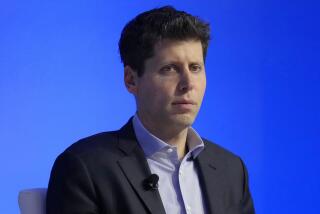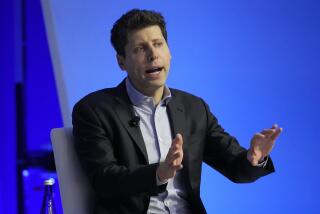Aura Opinions Are Poles Apart
Aura Systems Inc. may represent the next generation of Southern California manufacturers, a brilliant example of former weapons designers beating the region’s swords into plowshares.
Either that, or Aura will go down as one of the Southland’s greatest disappointments--from a business perspective, and particularly from the point of view of the growing list of investors who have snapped up the firm’s stock.
El Segundo-based Aura is pioneering potentially vast new uses for a simple scientific principle: magnetics. In place of the metal-on-metal systems of moving parts that make so many things work today--an electric car-door lock, for example--Aura uses electromagnetic waves to literally suspend parts in mid-air.
The movement of the part, either up-down or rotating, can then be controlled by currents generated in the magnets and sensors surrounding the base of the part.
That’s only a thumbnail explanation of Aura’s technology, but if you understand the basic concept, you understand Aura’s grand mission: The company wants to replace mechanical technology--which has dominated modern life since the 19th Century--with a magnet-based system that is cleaner, quieter and potentially more reliable, all because it eliminates friction in moving parts.
Some Aura fans compare it to other once-tiny firms that changed the world--such as Xerox Corp.
Aura’s doubters see only a bunch of eggheads at work on ideas that either don’t have commercial use, or that will quickly be stolen by bigger competitors.
Arthur Schwartz, Aura’s executive vice president, admits that to many people Aura just seems too good to be true. The idea of replacing the brute clang of metal parts with electromagnetic waves isn’t new, he concedes.
What Aura is perfecting, Schwartz says, is the balancing act within the magnetic force--the constant, 360-degree electronic sensing required to keep a force field even, so that a metal part is perfectly straight within the field. Only then can the part be accurately driven vertically, or spun, to produce the desired effect.
“What we have done has been missed by other people--why, I don’t know,” Schwartz says.
Founded in 1987 by a group of ex-Hughes Aircraft scientists (Schwartz was one, as was Aura President Harry Kurtzman), Aura was and still is largely a research firm. Many of its discoveries stem from work done for the Pentagon.
Now, after struggling for years to persuade major manufacturers of the commercial applications for its technology, Aura suddenly has found a burgeoning audience--and its first financial success:
* Aura now is working on prototype parts and machinery for some of the nation’s biggest manufacturers, including General Motors, Boeing and Caterpillar. In August, the firm signed a 17-year development pact with auto-parts giant Echlin Inc., which netted Aura a non-refundable, $1-million advance against future profits.
* Pumped-up by a wave of R&D; contracts, Aura’s revenues jumped to $6.54 million in the six months ended Aug. 31 from $3.78 million a year earlier. And the company has turned its first-ever profit.
Perhaps more significant, excitement over the company has remained high enough to support its stock price at what some consider astronomical levels. The shares closed Friday at $8.625 on the NASDAQ market, near the all-time high of $9.25 and up from a low of under $2 early in the year.
An $8.625 stock may not seem like much, except that Aura has nearly 25 million shares outstanding, a result of its extensive early capital-raising efforts with private investors. That gives Aura a gigantic market value of $216 million.
Is Aura worth that valuation? Some savvy traders don’t think so. The number of Aura shares sold “short”--a bet that the price will collapse--totaled 1.15 million in mid-November, a huge amount.
But more typical of Aura’s doubters is Michael Murphy, editor of the California Technology Stock Letter in San Francisco. Murphy says he wouldn’t short Aura, because “the technology is real.”
At the same time, he argues, “there’s very little in the technology that’s protectible” by patent. Murphy figures that even if some Aura ideas win contracts for mass production, bigger competitors will eventually crush Aura.
Schwartz says that’s baloney. “Anyone who tries to do anything (similar) runs across our basic blocking patent,” he insists.
Still, Aura has yet to show that its technology can in fact be put to use in mass-produced goods--for example, in the electromagnetic shock absorbers that the company believes may someday replace today’s hydraulic shocks on cars.
Schwartz admits that Aura can’t predict which of its many product ideas might be picked first for mass production by a GM or other major firm. But he says Aura is now focused on the products and joint-venture proposals “where we can really sink our teeth in, to get a return for our stockholders.”
The deal with Echlin--joining with an established manufacturer that could quickly churn out Aura products--”is a very good model for how we might proceed” in other areas, Schwartz says.
Yet the Echlin pact also exposed one of Aura’s potential problems: The money that would be required to finance Aura’s transition from a designer of products to a manufacturer would probably be impossible to raise. So the company has little choice but to find partners--and that raises the question of how well Aura will be able to control its own destiny, and thus its profits.
Schwartz, noting that Aura’s top officers and directors own a total of 28% of the stock, scoffs at worries that Aura management might give away the store. “Our goals are mercenary,” he says. “I want the value of my stock to go up.”
It helps that Aura’s scientists are advised by some veteran financiers: One Aura director is Peter C. Jaquith, an ex-investment banker with the firms Lazard Freres & Co. and Bear Stearns & Co. He owns 4.9% of the stock.
But the most important endorsement for Aura is the interest shown by its potential customers:
* W. R. Davis Engineering in Ottawa, Canada, is working with a prototype of a wave-generating machine that Aura designed. Aura’s magnetic technology is used to move a “paddle” to push water in a tank, simulating wave action for various scientific uses. Hydraulic wave machines now in use can leak hydraulic fluid--a problem Aura doesn’t have, notes Rod Bryce, general manager at Davis. “The tests (with Aura) are going along very well,” he says.
* Last spring, Swiss giant Nestle Inc. paid $1.5 million for a 5% stake in an Aura venture that could revolutionize cataract surgery. The procedure, still being tested, involves the injection of a tiny magnetic bead into the eye. The bead, controlled by magnetic force from outside the eye, is then moved around to pulverize the cataract.
* Aura and can manufacturer Ball Corp. are working on a new machine that would use magnet-controlled devices to pound out can bodies. Aura’s system would replace a metal-on-metal driver that Ball Corp. engineer Ed Miller describes as “very maintenance-intensive” because of the heavy mechanics involved.
Significantly, Aura’s design for the Ball Corp. machine now is hung up in court in Golden, Colo., in what could become a key test of the company’s patent protection. Adolph Coors Co. sued Aura, charging that Coors developed some of the technology Aura has used in its design.
A few weeks ago, the judge in the case issued a preliminary injunction barring Aura from further work on the machine, pending trial. Aura says it won’t wait for a trial and instead will seek to have the injunction overturned by proving that it was first with the technology.
Whatever the outcome, the suit illustrates the crossroads at which Aura--and its shareholders--now find themselves. One Southland broker who owns the stock put it this way: A few years from now, he says, “this will either be a 70-cent stock or a $70 stock--but I don’t know which.”
Aura’s Improving Finances
Some details from Aura Systems’ latest income statement and balance sheet, compared with a year earlier:
Six months ended Aug. 31: 1991 1990 Revenue $6,536,901 $3,778,148 Net income (loss) $217,274 ($2,656,750) Earnings (loss) per share $0.01 ($0.12) Cash balance $3,218,374 $798,875 Long-term debt none $7,122,236 Shares outstanding 24,979,453 22,102,445
Source: Aura Systems Inc.
More to Read
Inside the business of entertainment
The Wide Shot brings you news, analysis and insights on everything from streaming wars to production — and what it all means for the future.
You may occasionally receive promotional content from the Los Angeles Times.










